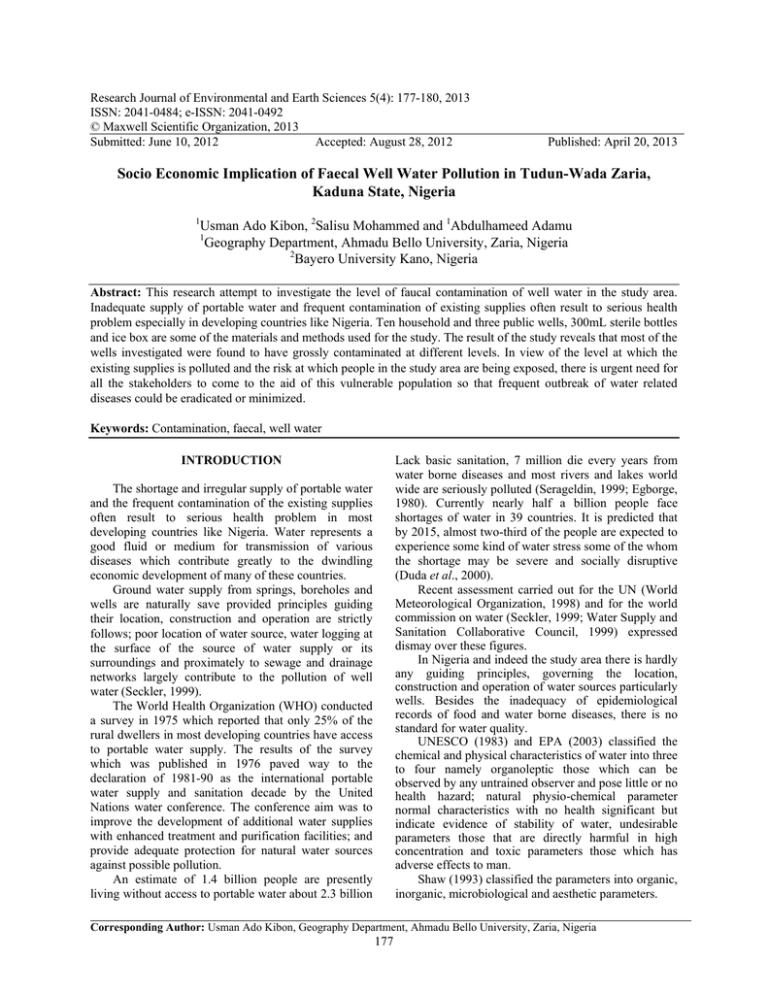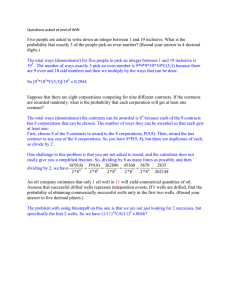Research Journal of Environmental and Earth Sciences 5(4): 177-180, 2013
advertisement

Research Journal of Environmental and Earth Sciences 5(4): 177-180, 2013 ISSN: 2041-0484; e-ISSN: 2041-0492 © Maxwell Scientific Organization, 2013 Submitted: June 10, 2012 Accepted: August 28, 2012 Published: April 20, 2013 Socio Economic Implication of Faecal Well Water Pollution in Tudun-Wada Zaria, Kaduna State, Nigeria 1 Usman Ado Kibon, 2Salisu Mohammed and 1Abdulhameed Adamu Geography Department, Ahmadu Bello University, Zaria, Nigeria 2 Bayero University Kano, Nigeria 1 Abstract: This research attempt to investigate the level of faucal contamination of well water in the study area. Inadequate supply of portable water and frequent contamination of existing supplies often result to serious health problem especially in developing countries like Nigeria. Ten household and three public wells, 300mL sterile bottles and ice box are some of the materials and methods used for the study. The result of the study reveals that most of the wells investigated were found to have grossly contaminated at different levels. In view of the level at which the existing supplies is polluted and the risk at which people in the study area are being exposed, there is urgent need for all the stakeholders to come to the aid of this vulnerable population so that frequent outbreak of water related diseases could be eradicated or minimized. Keywords: Contamination, faecal, well water Lack basic sanitation, 7 million die every years from water borne diseases and most rivers and lakes world wide are seriously polluted (Serageldin, 1999; Egborge, 1980). Currently nearly half a billion people face shortages of water in 39 countries. It is predicted that by 2015, almost two-third of the people are expected to experience some kind of water stress some of the whom the shortage may be severe and socially disruptive (Duda et al., 2000). Recent assessment carried out for the UN (World Meteorological Organization, 1998) and for the world commission on water (Seckler, 1999; Water Supply and Sanitation Collaborative Council, 1999) expressed dismay over these figures. In Nigeria and indeed the study area there is hardly any guiding principles, governing the location, construction and operation of water sources particularly wells. Besides the inadequacy of epidemiological records of food and water borne diseases, there is no standard for water quality. UNESCO (1983) and EPA (2003) classified the chemical and physical characteristics of water into three to four namely organoleptic those which can be observed by any untrained observer and pose little or no health hazard; natural physio-chemical parameter normal characteristics with no health significant but indicate evidence of stability of water, undesirable parameters those that are directly harmful in high concentration and toxic parameters those which has adverse effects to man. Shaw (1993) classified the parameters into organic, inorganic, microbiological and aesthetic parameters. INTRODUCTION The shortage and irregular supply of portable water and the frequent contamination of the existing supplies often result to serious health problem in most developing countries like Nigeria. Water represents a good fluid or medium for transmission of various diseases which contribute greatly to the dwindling economic development of many of these countries. Ground water supply from springs, boreholes and wells are naturally save provided principles guiding their location, construction and operation are strictly follows; poor location of water source, water logging at the surface of the source of water supply or its surroundings and proximately to sewage and drainage networks largely contribute to the pollution of well water (Seckler, 1999). The World Health Organization (WHO) conducted a survey in 1975 which reported that only 25% of the rural dwellers in most developing countries have access to portable water supply. The results of the survey which was published in 1976 paved way to the declaration of 1981-90 as the international portable water supply and sanitation decade by the United Nations water conference. The conference aim was to improve the development of additional water supplies with enhanced treatment and purification facilities; and provide adequate protection for natural water sources against possible pollution. An estimate of 1.4 billion people are presently living without access to portable water about 2.3 billion Corresponding Author: Usman Ado Kibon, Geography Department, Ahmadu Bello University, Zaria, Nigeria 177 Res. J. Environ. Earth Sci., 5(4): 177-180, 2013 Fig. 1: Kaduna state showing the study area It is a common feature with semi rural or suburban communities in developing countries like Nigeria; the study area is also confronted with various forms of environment hazards and solid waste disposal problems. The water supply is quite erratic and the housing is of poor quality. There is neither comprehensive health programme nor is there a proper enlightenment to address the ignorance of the people towards environmental sanitation. Taps are located along few streets and strategic points, therefore most houses have no tap water. Even during the raining season a large number of people rely on well water supply while some harvest their water from roofs. Because of these problems and frequent outbreak of water borne diseases in the study area, this research is aim at examining the quality of well water in Tudun-Wada Zaria, Kaduna, Nigeria. Collection of samples: Ten households and three public wells were randomly selected and water samples were collected in 300ml sterile bottles and stored inside an ice box for three days before analyzed. The samples were collected in accordance with standard methods (APHA, 1985). The distance between toilets and wells location ranges from 4.6 m to 11.7 m. The level of bacterial densities of the water generally (total coliform, faecal coliform and faecal streptococci) were determined using M-E ndo |(oxide) and all colonies with pink to dark red colour with a metallic sheen were regarded as positive. M-FC medium (oxide) and Menterococcus agar (Difco) were used to determine the feacal coliform and feacal streptococcus densities respectively. For identification of salmonella and other bacteria, water samples were incubated in selenite F both and incubator at 45°C for 24 h. After which selected colonies were mixed on macconkey agar (oxide) Brilliant Green BGA (Oxide) and Salmonella Shigella agar (SSA) Oxide. MATERIALS AND METHODS The study area: The area under investigation is geographical located at latitude 11°11mN and longitude 7° 38mE and it has a population of 233342 of which 12764 are males while 10578 are females as at 1991 census. There is inadequate rainfall (annual rainfall is approximately (1112 mm) most of which occurs between the months of June and September (Iloeje, 2004). During the dry season, there is serious shortage of water supply because most of the wells use to dry up or they supply water only in the morning and no water for the remaining part of the day. Figure 1 shows the map of the study area. RESULT AND DISCUSSION Almost all the sources (well water) examined were found to have grossly contaminated with an average of 4×105 coliforms/100 mL, 3.9×103 feacal streptococcus/ 100 mL Table 1. Other entric obacteriaececie isolated include klesbsiealla sp and proteus sp from 5 (38%) of the water samples citrobacter sp, pseudomonas sp and salmonella sp or about 4 (31%); providence sp on 2 178 Res. J. Environ. Earth Sci., 5(4): 177-180, 2013 Table 1: Characteristics of water supply at tudun-wada zaria Distance from toilets to the Total coliform Faecal coliforms Feacal streptoccus Occurrence No of well well location (m) (No/100 mL) (No./100) (No/100) other bacteria 1 8.3 1.2 × 106 2.5 × 103 2.2 × 102 s, f, s 2 9.1 3.1 × 106 1.4 × 104 1.8 × 103 g, h, b 3 9.5 3.4 × 105 1.5 × 103 5.2 × 103 c, g 4 5.7 5.6 × 105 2.5 × 103 3.5 × 102 e, g 5 5.8 8.3 × 105 3.1 × 106 2.3 × 102 g, f, d 6 7.5 6.4 × 105 4.3 × 103 4.1 × 102 b, c 7 6.3 5.2 × 105 1.5 × 103 54 × 102 d, f 8 8.5 4.4 × 106 7.4 × 103 7.0 × 102 c, g, b 9 10.2 2.3 × 105 3.5 × 103 6.5 × 102 f, c 10 11 1.9 × 105 2.8 × 103 1.2 × 103 e, h 11 4.8 9.5 × 105 4.5 × 103 3.6 × 102 d, a 12 10.3 4.8 × 105 4.5 × 103 4.5 × 102 e, f 13 10.7 9.8 × 105 1.6 × 103 Dsh b, e a: Citrobacter sp; b: Klebsilla sp; c: Proteus sp, (d) providence sp; d: Pseudomonas sp; e: Salmonella sp; f: Straphlococcus aureau (15%) and stapholo coccus sp on 8(62%) well water samples. The survey showed that about 8(62%) of the 13 wells sampled had FC:FS (faecal coliform to feacal streptococcus) ratio greater than 3.5; and that 2 wells (15%) had ratios of less than 0.7 the remaining 3 wells (23%) indicated ratios between these extremes Table 1. The distance of the toilet to the wells has significant relation with the bacterial densities. A survey of 75 randomly selected houses shows that about 85% of the house have shallow pit latrines and 91% Have just one pit latrine servicing people ranging from 10-19 and above per household. Five (5%) of the houses use bucked latrines and only a small percentage (7%) used septic tanks. The study also revealed that majority of the people in the study area depends on the public wells. However, very few about 5% of all the houses have their supply from pipe water. FC:fs ratio 5.3 0.6 7.1 9.3 2.1 5.6 1.3 10.8 5.1 0.6 5.0 6.2 7.8 water through underground seepage (Peters and Meyback, 2000). According to WHO Standard, wells should be located at least 30-33 meters away from likely source of pollution. Conversely, from this study, the longest distance between wells and toilets is 11 m. The presence of staphylococcus sp in 8 (62%) of the wells sampled is a confirmation of pollution from human activities around the wells. It is very common to find people carrying out washing and bathing activities especially around source of water. The high bacterial densities found could be the result of proximity to stagnant open sewer and refuse dump sites around some wells. The later has the potential to leach generation which could affect the underground water. CONCLUSION The study attempt to investigate the faecal contamination of sources of water supply particularly well water in the study area. Water which is one of the basic needs of man is very essential for growth and development of any society. Inadequate or poor water supply is a common phenomenon in most developing countries like Nigeria. In view of the risk at which the population in the study area are exposed due to inadequate and poor water supply, it has become imperative for all the stakeholders to invest more on the social well being of the people especially water supply and other related amenities so that frequent outbreak of water related diseases could be minimized and pave way towards the realization of millennium goals of the federal government. It is also very important to embark on public enlightenment campaigns on the need to treat such as boiling and or disinfection of water before use. In addition, government in collaboration with local community leaders should evolve guidelines for construction, operation and maintenance of wells so that frequent outbreak of water related diseases could be controlled. Solid wastes and sewage disposal facilities should be improved in the study area. The accessibility to adequate and portable water supply will ensure a healthy and productive society. DISCUSSION The result presented in Table 1 shows a serious faecal contamination of well water supply in the study area. Almost all the randomly selected samples had certain level of bacterial densities higher than the W.H.O recommended standard of less than 10 coliform/100m/s for untreated water (WHO, 2001; Alam et al., 2006; Wagner and Lanoix, 1958). The high bacterial densities in the well water could be attributed to the fact that entric bacteria have a tendency to survive for a long period of time depending on the weather conditions. The possibility of re-growth of bacteria in water containing some mineral salt could also have accounted for the high bacteria densities. The identification of salmonella sp, shigella sp and other entric pathogens from some of the wells confirmed faecal pollution and signifies the level of the health hazard posed by the water supply. The contamination of almost all the wells might have been the result of the proximity of wells to toilet facilities, gutters, sewers, refuse dump sites as well as various anthropogenic activities around the wells. Entric pathogens may sometimes be carried into sources of 179 Res. J. Environ. Earth Sci., 5(4): 177-180, 2013 REFERENCES Seckler, D., 1999. Water for Foods in 2925: The Major Issues. News Flow, No. 2/99, IWMI. Serageldin, I., 1999. World’s Rivers in Crisis, Some are Dying, Others Could Die. Retrieved from: http:// watervision.cdinet.com/riversrelease.html. Shaw, A.J., 1993. Morphological uniformity among widely disjunct populations of the rare copper moss. Scopelophila cataractae (Pottiaceae). Syst. Bot., 18: 525-537. Wagner, E.G. and J.N. Lanoix, 1958. Excreta Disposal for Rural Areas and Small Communities. World Health Organization Monograph Series, No. 39, Geneva. WHO, 2001. Environmental Health Criteria 224. Arsenic and Arsenic Compounds Seconded World Health Organization, Genevar. Alam, M.A. and D.U. Elahi Alkam, 2006. Risk and water quality assessment over river sitaliky in Bangladesh arad. Open Int. J., Retrieved from: Http://acajournal.com/2006via/part2/pa. Duda, R., P. Hart and P. Stork, 2000. Pattern Classification. John Wiley and Sons, New York. Egborge, C.E., 1980. Environmental pollution problems of small communities in the Niger Delta. Proceeding of 6th Water and Waste Engineering for Developing Countries (WEDC) Conference. Iloeje, M.P., 2004. A new Geography of Nigeria. Published by Longman Nigeria PLC 52 Oba Akran, Avene, P.M.B 21036, Ikeja, Lagos, Nigeria. Peters, N.E. and M. Meyback, 2000. Water quality degradation effects on fresh water availability impacts of human activities. IWRA Water, 25(2): 185-193. 180







